There are several important pieces of public art in our Ward.
The Messenger is a statue, a sculpture in bronze with very dark patination, completed by David Wynne in 1981, of a large horse and rider. The horse, with a slightly raised left leg, looks towards the railway station. The rider, seated bareback, raises his left hand in the air above his head and his right hand to his mouth, as if calling. It is fully life-size and mounted on a high (7 foot) plinth of marble and granite slabs. The total height is 150 inches. It was a major commission for the sculptor, which took four years to complete from his first idea and inspiration, on receipt of the brief – through roughing out, refining and casting in a foundry, to the final unveiling and installation.The creation is located directly outside the main entrance to Quadrant House in the Quadrant.
Even more striking is the remarkable mural by the famous Spanish “street” artist from Bilbao, Eva Mena, on a wall in Wellesley Road. This is said to be of the American singer and musician Erykah Badu. The work was commissioned by the owners of the building, Indepth Hygiene Services. It was painted in three days in 2010, when the artist came over from Spain to paint it. It is entirely typical of her street art, which is to be found on walls in many parts of the world, including Egypt, Ireland and Spain, as well as Sutton.
There are four structures of some historic significance in our Ward.
Most people are aware that historic buildings might be “listed” to prevent their being inappropriately developed or demolished. This is, however, a national system, and local authorities can prepare lists of local structures that are of significance locally though not grand enough to go on the national list.
There is one structure in Sutton South Ward that is of such significance, historically and architecturally, that it makes the national list, and there are three others on the local list.
The four structures in Sutton South Ward are:
- the Registrar’s office (The Russetings) in Worcester Road, a Victorian house that it is believed the Walls family, famous for Walls ice cream and Walls sausages, lived in, though this is disputed
- Stowford in Brighton Road, a Victorian house, now the Eagle House school
- the pavilion of the Highfield Lawns tennis club at the junction of Mayfield Road and The Ridgway, as an example of an Edwardian tennis pavilion, build by local builder Percy Vere Windebank in 1908
- a Victorian sewer vent pipe in Hillcroome Road, one of 24 in the area, manufactured at an ironworks (W. Macfarlane and Co.) in Glasgow and erected when mains sewerage came to the area in the nineteenth century. This is a nationally listed structure.
The most unusual and interesting of these is the sewer vent pipe, pictured below.
This is one of a number of Drain Pressure Release Pipes, also known as ‘Stink Pipes’, thatcan be seen at various locations within the old Carshalton Urban District Council boundary. It is the only one in our Ward. They have been listed on the basis of the criterion that they are important to the townscape view.
They were produced by W. Macfarlane & Co. of Glasgow, a prestigous Victorian Ironworks. The company employed imaginative designers and produced huge amounts of ornate and decorative ironwork. The pipes are extremely tall with an ornate top fixture comprising a large arrow, a globe with four trumpetlike funnels and a spike spire piercing a crown. The height and funnels may be to ensure the gas disperses efficiently so as not to inconvenience local residents. It is not known what purpose the arrow has, whether to indicate the direction of sewer flow or act as a weather vane to indicate wind direction.
They serve two purposes, firstly to prevent a build up of pressure in underground sewers in the event of a blockage, and secondly to vent off any hydrogen sulphide gas. This gas, which smells of rotten eggs, can build up when sewage becomes septic, on long runs, or when the speed of the sewage is slow in flat areas. It is extremely corrosive and can eat through the concrete pipes. The sewerage system would have become a necessity after the rapid increases in population and residences in Sutton and Carshalton at the end of the 1800s. Prior to this sewage would have been dispersed into cesspits and drainage ditches, with a risk of contamination of the drinking water supply, contributing to ill health.
The history of W. Macfarlane and Co. and their foundry, the Saracen Foundry, is fascinating. In 1851 Walter Macfarlane (1817-1885) established his company in a disused foundry in Saracen Lane in Gallowgate, Glasgow, and named it Saracen Foundry. It later moved to Washington Street, near the River Clyde. By 1872 his nephew, also named Walter MacFarlane (1853–1932), joined the rapidly expanding company and they relocated to Possilpark, a site of 100 acres on the outskirts of the city. Here a foundry with railway access and a village-styled infrastructure to house the workforce was built. In a decade it housed 10,000 people but the vast iron-founding site caused much pollution. The young MacFarlane made standardisation and good design the key to the company’s successful development. The foundry’s work was used on prestigous developments and widely distributed. During the Second World War Possilpark industrial works was a vast and well-lit target for attack. The recovery of iron to melt down for the war effort also removed much of Saracen’s work. After the war, the collapse of the British Empire, the move away from steam power and the use of new designs and materials led to a vast decline in orders. In 1967 the foundry at Possilpark closed.
In considering the history of the Ward, it is appropriate to mention Harold Berridge, a famous engineer who lived in the road next to the Subsea7 building off Brighton Road, now named after him – Berridge Close.
The photo shows Trish and Richard at the opening of the re-named Berridge Close in 2016.
This is to remember Harold Berridge (1872-1949), a celebrated engineer who lived in a house on the site now occupied by the Subsea7 offices, from the 1920s through to 1949. Berridge was an engineer who travelled the world and contributed to many important civil engineering projects worldwide, including the building of tunnels under the river Hudson in New York in 1902 and the development of the port of Aden – in modern day Yemen – in the ensuing decade. He settled in Sutton in the 1920’s to work on housing development for the London County Council. He is noted in civil engineering circles as the inventor of equipment for the testing of concrete, based on principles which are still relevant to modern day equipment used for this purpose.
Harold Berridge was born in 1872 and went to the City of London school. After serving a pupilage in civil engineering from 1890 to 1893 he became the resident engineer at Poole Harbour in 1893.
After working as an engineer for companies including John Mowlem & Co. and the City and South London Railway in the period to 1898, he became Assistant Superintendent supervising the approaches to the Hudson Tunnel, in New York, in 1902, before becoming Chief Engineer to the Aden Port Trust in 1904. He was involved in work in Aden through to 1924, after which he worked on housing development schemes for the London County Council through to 1931. During his time in Aden he was awarded the OBE.
The Times of 20 June 1949 reports his death, on 17 June 1949, at 8 Worcester Gardens, Sutton, Surrey. Worcester Gardens stood on the site now occupied by the Subsea7 building in Brighton Road, and was a turning off the Brighton Road. Berridge lived in a Victorian house in Worcester Gardens.
Berridge is remembered for his patents relating to principles and equipment for the testing of concrete, including one dating from 1925 under the title “Contractible and expansible supporting means suitable for use in the construction of pipes, tunnels, bridges and other bodies or structures.” In 1932 he submitted an important patent entitled ”Apparatus for Testing the Strength of Materials.” His equipment for the testing of concrete was based on principles which are still relevant to modern day equipment used for this purpose.
The railway bridge at Sutton station has been brightened up with a painting by the renowned artist Lionel Stanhope, whose art has brightened up many railway stations.
The façade of the railway bridge, as you come out of Sutton station and turn left, was a patchwork of various colours. The Council first tried to interest Network Rail in making the bridge look more attractive, over four years ago, during the “Sutton Gateway” project, which involved re-paving the area around the station and the installation of the clock opposite Sutton station.
The parapet of the bridge required extensive cleaning and preparation before painting commenced. Lionel Stanhope produced a design which incorporated the word “Sutton” in the typeface traditionally used by Southern railway, and a depiction of the historic Sutton locomotive. The locomotive “Sutton” came into the possession of the Council many years ago and is a 144 year old, 28 tonne, 26 feet, A1 class Terrier steam engine. It is currently with a heritage railway undertaking in Tunbridge Wells who have undertaken to restore it.
The work was jointly funded by Network Rail and Sutton Council. The painting is an addition to an area becoming famous for its street art. Within two hundred yards you can find the remarkable statue “The Messenger”, described above, and the remarkable mural by the famous Spanish “street” artist from Bilbao, Eva Mena, on a wall in nearby Wellesley Road, also described above.
As the artwork is not easy to photograph, the picture above is the CGI prepared before the painting was undertaken.

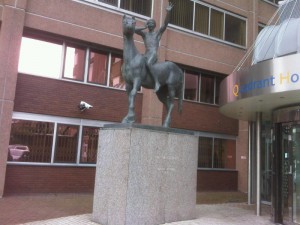

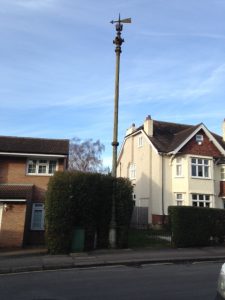
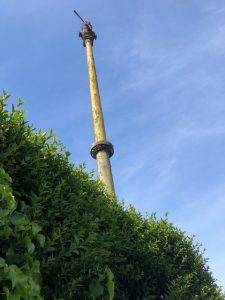
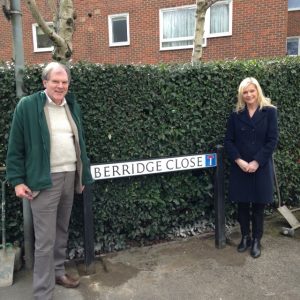
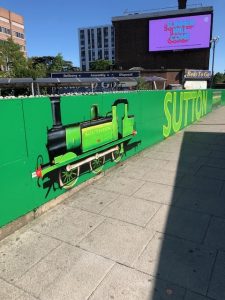
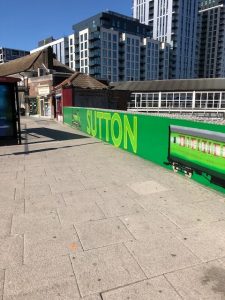
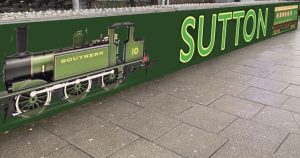
[…] Public Art in Sutton South Some of our ward’s best public artwork […]